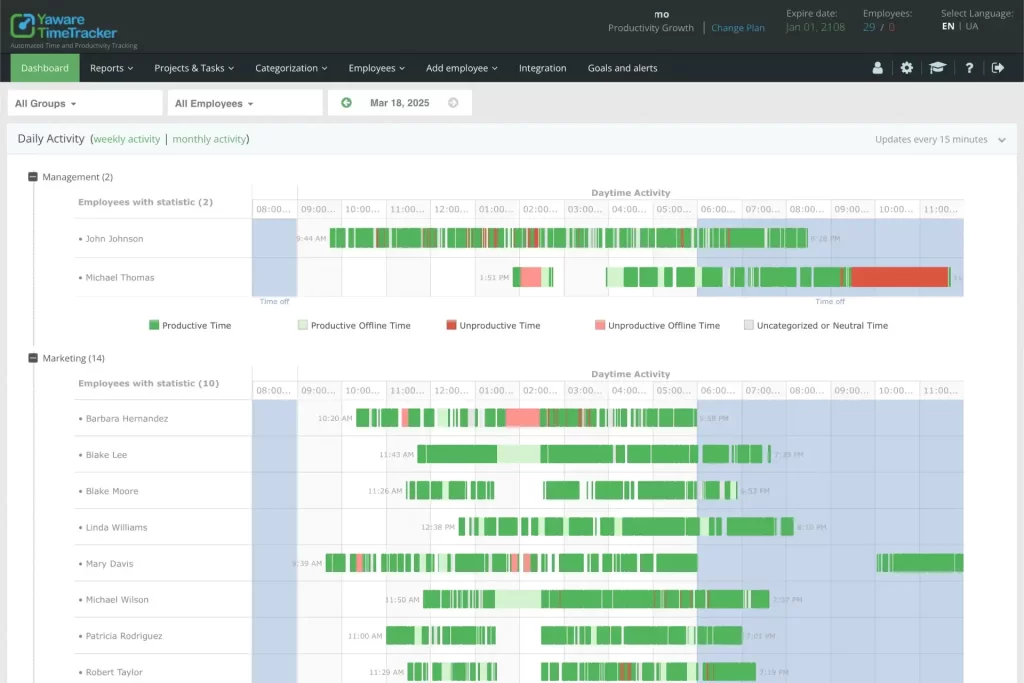What are the real reasons behind declining employee productivity?
In today’s data-driven organizations, productivity is no longer just a buzzword — it's a competitive differentiator. Yet, despite overwhelming investment in management systems and operational tools, 73% of business leaders report productivity stagnation or decline over the past two years, according to recent Gallup research. Leaders are under rising pressure to deliver more with less, particularly amid hybrid work shifts and increased employee burnout. For HR executives and operational managers, understanding what truly drives — and hinders — employee output is essential to unlocking sustainable growth.
Employee productivity often suffers due to misaligned priorities, inefficient time usage, and lack of real-time insights. Addressing these root causes requires data-informed management and modern workforce technology.
How can HR leaders support employee performance without micromanagement?
The shift from surveillance to enablement
Top-performing organizations have outgrown legacy models of oversight. Instead of practicing control through constant check-ins or message tracking, they now focus on enablement: giving employees clarity, flexibility, and tools they can trust. This starts by measuring productivity holistically, rather than by sheer volume of output. When HR teams adopt employee activity tracking software, not to monitor but to inform, they empower both employees and team leads to collaborate more efficiently and adjust workflows in real-time.

From static policies to dynamic environments
A recent study by McKinsey found that companies with adaptive performance systems — those accommodating individual work rhythms and transparency — are 4x more likely to retain top talent. That means the role of HR has evolved: it’s no longer just about compliance or engagement. It’s about architecting responsive environments where data and human behavior intersect. This includes intelligently deploying time tracking software for small business teams — especially hybrid or asynchronous operations — to reveal patterns and improve decisions proactively.
Why do traditional timekeeping methods fail in modern work models?
The invisibility of digital work
Legacy timecards, manual reports, and general hours-logged dashboards fail to reflect the complexity of modern knowledge work. A software developer and a marketing strategist could both work eight hours — but one might finish coding a feature, while the other spends five hours aligning stakeholders on a campaign kickoff. Traditional systems can’t capture that nuance. That’s where employee time management solutions, layered with activity context and project tagging, provide a much more actionable view.
The risk of misaligned metrics
Without the right tools, teams often chase false productivity signals — like inbox zero or constant online presence. In reality, such metrics rarely correlate to value creation. A robust employee work tracker distinguishes between time spent and meaningful progress. It helps managers focus less on “Are they working?” and more on “Are they moving the business forward effectively?”
What problems does employee time tracking software actually solve?
Teams today face persistent dilemmas: missed deadlines despite full-capacity schedules, unclear project ownership, and lagging deliverables no one foresaw. These issues aren’t due to laziness but to invisible inefficiencies. Well-deployed employee time tracking software acts as a diagnostic lens. When integrated seamlessly with workflows, it uncovers gaps, surfaces bottlenecks early, and aligns efforts with outcomes better than any end-of-month report ever could.
This brings us to some common time management pain points that time tracking tools are best suited to resolve:
- Unclear time allocation across teams: Most managers underestimate how scattered their team’s focus is. Time tracking reveals where attention goes — and whether it matches strategic goals.
- Invisible overloads and quiet underperformance: High performers may silently burn out while others are underutilized. Time logs offer clues to re-balance workload fairly across team members.
- Unactionable project retrospectives: Post-mortems often lack quantitative insight into what took too long and why. Timeline data makes these learnings precise, not anecdotal.
- Manual reporting drag: Employees spend hours preparing status reports. Automation replaces that friction with real-time dashboards from automated time tracking software, freeing up bandwidth for actual work.
These aren't hypotheticals. They’re daily frictions that silently erode productivity and morale if unaddressed.
What is employee time tracking software, and how does it work?
Defining the ecosystem
Employee time tracking software is a category of business tools designed to record, analyze, and optimize how teams spend their work hours. It typically includes features like automatic time logging, project-based tagging, idle detection, productivity scoring, and custom reporting. Advanced systems can also integrate with calendars, communication tools, and project management platforms —drawing data passively to reduce friction for employees.

How it boosts outcomes strategically
Unlike surface-level monitoring solutions, time tracking software provides decision-makers with contextual visibility. For example, when a marketing team sees that ideation consumes 40% of their project hours, they can reconfigure timelines or support structures upstream. Importantly, these tools also validate instinct: confirming whether that “time sink” you suspect is truly costing you hours, or merely feels frustrating.
What traits should leaders prioritize when choosing tracking tools?
Not all time tracking solutions are created equal. Some are disruptive and compliance-focused. Others are designed to integrate invisibly into workflows. Leaders pursuing sustainable productivity gains should look for tools built around trust, transparency, and operational value — not surveillance.
The best-performing teams we’ve studied use software with the following characteristics:
- Low-friction implementation: Tools that require no manual entry and sync with daily tools (like Slack, Jira, or Outlook) see higher employee adoption long-term.
- Project-level insights: Beyond individual time logs, look for systems that track work against outcomes and deliverables.
- Real-time anomaly alerts: Smart platforms notify managers when workloads spike or patterns deviate — preventing burnout or deadline surprises.
- Respect for employee autonomy: Transparent, opt-in models foster a culture of improvement, not policing.
Ultimately, it’s about helping people do their best work — not watching them do it.
How can organizations turn insights into impact?
The productivity-feedback loop
Time tracking works best not as a siloed tool, but as the foundation of a broader performance strategy. Consistent feedback loops are essential: teams review work patterns weekly, compare productivity over project cycles, and test interventions. One fast-scaling SaaS startup saw engineering velocity rise 18% after realigning sprint planning using time-derived attention maps — revealing where distractions were clogging their code shipping pipeline.
Putting data into practice
For data to become a driver of growth, organizations should invest in training managers on interpreting and acting wisely on time metrics. Dashboards don’t replace judgment, but they sharpen it. When deployed correctly, systems like employee time monitoring software become catalysts for operational evolution — not just sources of numbers.
Productivity clarity drives performance gains
In the pursuit of sustainable growth, understanding how and where employee time is invested is no longer optional — it’s strategic necessity. Productivity isn’t about working harder, but working smarter with full visibility. By integrating modern employee time tracking solutions rooted in trust and context, organizations gain actionable insight into what truly fuels success.
Ready to address time leaks that hinder performance? Adopt data-informed tracking tools that uncover inefficiencies, rebalance effort, and align workflow investment with strategic outcomes. Start today — and see measurable clarity by next quarter.

